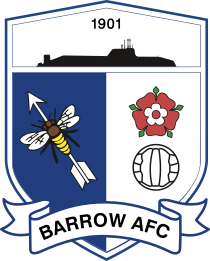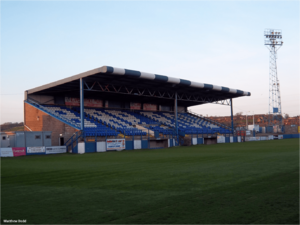Barrow A.F.C. facts for kids
Barrow Association Football Club is a professional football team from Barrow-in-Furness, Cumbria, England. They are often called "The Bluebirds" because of their blue and white team colours. The club currently plays in EFL League Two, which is the fourth highest level of football in England.
Barrow AFC joined the Football League in 1921. They were promoted to the Third Division in 1967, which was their highest league position ever. However, they left the Football League in 1972. After 48 seasons playing in non-League football, Barrow returned to the Football League in 2020 as champions of the National League. They are the only club to have been promoted back to the Football League after being voted out.
Since 1909, Barrow has played their home games at Holker Street. The biggest crowd ever at Holker Street was 16,874 fans for an FA Cup match in 1954.
Contents
History of Barrow AFC
How it all started
Barrow AFC was formed on July 16, 1901. They first played at the Strawberry Ground before moving to other locations. In 1903, the club joined the Lancashire Combination league. They moved to their current home, Holker Street, in 1909. Barrow won the Lancashire Combination championship in 1920–21. This win helped them become one of the founding teams of the Football League Third Division North in 1921.
Years in the Football League
In their early years in the Football League, Barrow didn't have much success. Their best finish before World War Two was fifth place in the 1931–32 season. After the war, they remained in the lowest division. In the 1950s, Barrow had some exciting FA Cup matches. Their record crowd of 16,874 watched them play Swansea Town in 1954.
In the late 1960s, Barrow finally earned promotion! They finished third in the Fourth Division in 1966–67. The next season, they reached their highest-ever league position, finishing eighth in the Football League Third Division.
However, things changed quickly. By 1972, Barrow faced financial problems and poor results. They were voted out of the Football League and replaced by Hereford United. This meant Barrow had to play in non-League football again.
Back to non-League football
After leaving the Football League, Barrow joined the Northern Premier League in 1972. In 1979, they were invited to join the new Football Conference, which was the top non-League division.
Barrow won the FA Trophy in 1990, which is a very important cup for non-League teams. They beat Leek Town in the final at Wembley. This was their first major trophy as a non-League club.
Challenges in the 1990s
The 1990s were a tough time for Barrow. In 1995, a businessman named Stephen Vaughan bought the club and invested money. He built a new stand at the stadium. However, the club later faced serious financial difficulties. It was discovered that the club's stadium, Holker Street, had been sold.
In 1999, the club was in danger of closing down. A group of members and fans stepped in to help. They worked hard to get the stadium back and keep the club running. With support from the Football Association, Barrow was able to join the Northern Premier League again. The fans eventually bought the stadium back in 2002.
Barrow continued to improve. In 2008, they won the play-offs to get promoted to the Conference National, which is the top non-League division.
National League success
In 2009, Barrow had an exciting FA Cup run. They beat Brentford and then played against Middlesbrough, a team from the top league, in the third round. Over 7,000 Barrow fans traveled to Middlesbrough for the match!
In 2010, Barrow won the FA Trophy again, beating Stevenage Borough 2-1 at Wembley Stadium. This made them the only club to win the FA Trophy at both the old and new Wembley stadiums.
After a few ups and downs, Barrow was promoted back to the Football League in 2020. They won the National League championship, which was a huge achievement!
Back in the Football League (2020–present)
Barrow's first game back in the English Football League in 48 years was a 1-1 draw against Stevenage in August 2020. They secured their place in the Football League for the next season with a 2-0 win against Forest Green Rovers in April 2021.
In May 2022, Pete Wild became the new manager. Under his leadership, Barrow's performance improved, and they finished 9th in the EFL League Two in the 2022–23 season.
In the summer of 2023, Barrow started a B Team for younger players. This team plays in The Central League. In May 2024, Pete Wild left the club, and Stephen Clemence took over as manager. However, in January 2025, Andy Whing became the new head coach.
Team colours and badge
Barrow's main colours are blue and white. They used to play in black-and-white stripes when the club first started. Over the years, their kit designs have changed, sometimes being mostly blue, sometimes mostly white, and sometimes with stripes.
The club's badge has a bee and an arrow, which is a clever way to show "B-arrow" (Barrow). It also features a submarine, representing the town's shipbuilding history, a Tudor rose, and a football.
Home stadium: Holker Street
Holker Street has been Barrow's home ground since 1910. It was once a rubbish dump before becoming a football stadium! The first game there was a 5-2 win for Barrow.
Over time, the stadium was improved with covered stands. The record attendance was in 1954, with 16,784 fans. Floodlights were added in 1963. In 2020, a new roof was added to one end of the ground.
Since July 2022, the stadium has been known as the SO Legal Stadium due to a sponsorship deal.
Training ground
While the team plays its home games in Barrow, the players train in Moston, Manchester. They share the training ground of F.C. United of Manchester, called Broadhurst Park.
Players
Current squad
|
|
Management
| Position | Name |
|---|---|
| Sporting Director | |
| Head Coach | |
| Assistant Head Coach | |
| Head of Football Operations | |
| 1st Team / Set-Piece Coach | |
| Goalkeeping Coach | |
| Head Physiotherapist | |
| Physio | |
| Strength & Conditioning Coach | |
| Performance Analyst |
Records
- Record attendance: 16,874 vs. Swansea Town, January 9, 1954
- Best league performance: 8th in Third Division, 1967–68
- Best FA Cup performance: Third round (achieved many times, most recently in 2021–22)
- Best League Cup performance: Third round (achieved in 1962–63, 1967–68, and 2024–25)
- Best League Trophy performance: Round of 32 (Northern Section), 2022–23
- Best FA Trophy performance: Winners, 1989–90 and 2009–10
Honours
League
- Fourth Division (level 4)
- Promoted: 1966–67
- National League (level 5)
- Champions: 2019–20
- Conference North (level 6)
- Champions: 2014–15
- Play-off winners: 2008
- Northern Premier League
- Champions: 1983–84, 1988–89, 1997–98
- Lancashire Combination Division One
- Champions: 1920–21
Cup
- FA Trophy
- Winners: 1989–90, 2009–10
- Lancashire Senior Cup
- Winners: 1954–55, 2023–24
- Northern Premier League President's Cup
- Winners: 2001–02, 2003–04
- Peter Swales Shield
- Winners: 1984–85
- Lancashire Junior Cup
- Winners: 1980–81
Images for kids
-
Blackpool players warming up before a friendly match at Barrow in 2019.
See also
 In Spanish: Barrow Association Football Club para niños
In Spanish: Barrow Association Football Club para niños





